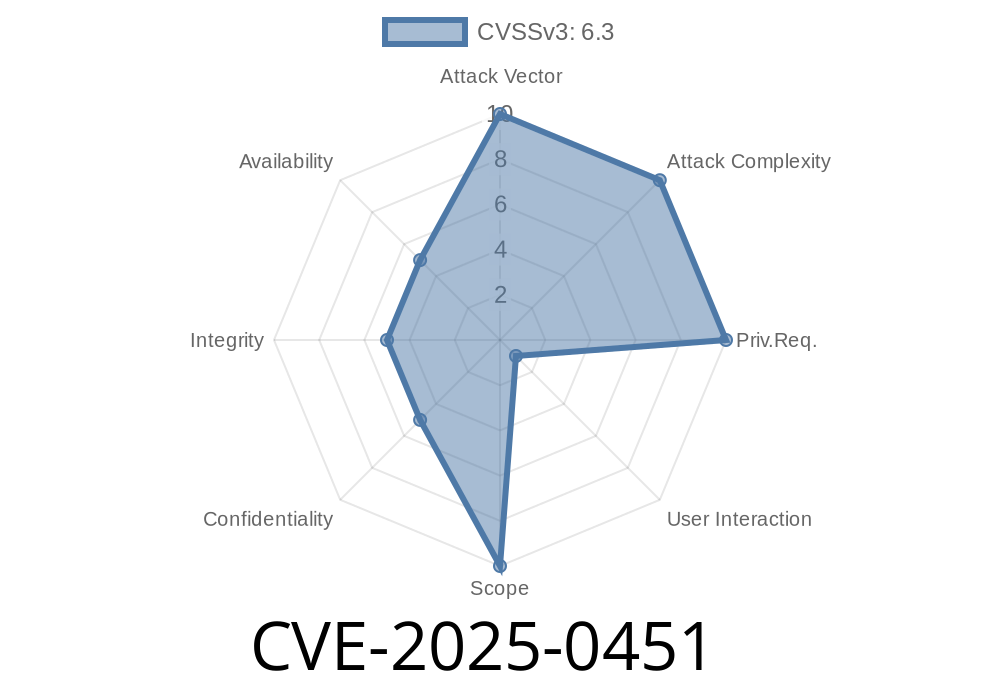In the competitive world of web browsers, security has always been a top priority. Google Chrome, being one of the leading web browsers, has faced its fair share of issues throughout the years. One such issue is the CVE-2025-0451 vulnerability which was discovered in Google Chrome prior to version 133..6943.53. This vulnerability existed due to an inappropriate implementation in the Extensions API. Although it has been patched in newer Chrome versions, it's essential to understand the severity of such flaws and potentially others like this to ensure a safer browsing experience moving forward.
What is CVE-2025-0451?
CVE-2025-0451 is a Common Vulnerabilities and Exposures (CVE) number assigned to a specific security vulnerability related to Google Chrome. The actual vulnerability lies in the inappropriate implementation in the Extensions API, which allowed a remote attacker to perform UI spoofing through a specially designed Chrome extension. If the attacker managed to convince the user to perform specific UI gestures, they could have potentially exploited this flaw.
Google Chrome's security team had classified this vulnerability as "Medium" in terms of severity. This may not have been widely discussed or widely known. However, this serves as a reminder of how security flaws can exist even in popular and heavily developed web browsers.
How It Worked
The inappropriate implementation in the Extensions API allowed the remote attacker to create a special Chrome Extension which could be used to perform a UI spoofing attack. In simple terms, UI (User Interface) spoofing occurs when the attacker manipulates a legitimate interface to deceive the users and trick them into revealing sensitive information or performing unintended actions.
Upon installing the malicious extension, the attacker could trick the user into performing specific UI gestures such as clicking on a particular button or navigating through menu options. Once the user completed these actions, the vulnerability would be exploited, and the attacker could take over the interface and potentially manipulate it for fraudulent activities.
To conceptualize this better, let's consider a theoretical code snippet of a specially crafted Chrome Extension:
chrome.runtime.onInstalled.addListener(function() {
chrome.browserAction.onClicked.addListener(function(tab) {
chrome.tabs.executeScript(tab.id, {
code: `document.body.innerHTML = '<h1>UI Spoofed</h1>';
// Add more malicious code below`,
});
});
});
The code above is just a basic example indicating how a rogue extension could manipulate the victim's interface. Please note this is a fictional example and is not intended for malicious use.
The discovery and patching of CVE-2025-0451 were reported on Google's official "Chromium" project
1. Chromium Security: chromium.googlesource.com (Search for "Fix the reported UI spoof.")
2. Chrome Releases Blog: googlechromereleases.blogspot.com
Exploit details
As this vulnerability was classified as "Medium" severity, it is believed to have had a moderate impact on users. However, it is still essential to discuss the potential exploits that might arise from a vulnerability like this:
1. Phishing: Attackers could have crafted a user interface that convincingly imitated a well-known website, such as a reputable email service, and tricked users into providing their login credentials or personal information.
2. Unauthorized actions: The attacker could have potentially tricked the user into unknowingly performing actions such as clicking on malicious links or installing further malware onto their device.
Conclusion
The CVE-2025-0451 vulnerability is an important reminder of the ever-evolving security landscape in web technologies. As responsible internet users, we must always remain vigilant and be aware of such vulnerabilities, even in widely trusted and popular products like Google Chrome. To mitigate risks like these, users should ensure they keep their software up-to-date, be cautious about the extensions they install and interact with, and follow best practices to maintain a safer browsing experience overall.
Timeline
Published on: 02/04/2025 19:15:32 UTC
Last modified on: 02/07/2025 22:15:14 UTC
